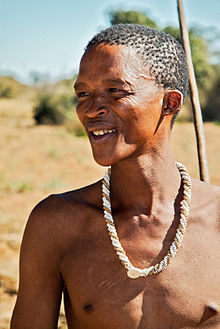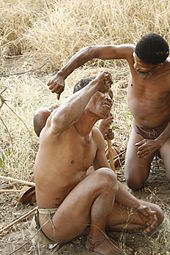(This is not your typical Entrepreneur how-to book.)
How Startups can Survive the Drought and Find Investors
 The more you can successfully bootstrap the company, and
progress through your own financing or machinations, the more you impress
Investors with your ability to deliver. So consider this a test you must pass –
whether you get funding or not. If you want to know how to endure “the drought”
and go on to find money, think of the Bushmen.
Now generally referred to as the San,
they live in the Kalahari Desert where there are no camels and few oases with
springs or even wells where they can pump water out of the ground. They get
rain during one season of year, and conserve what they can with little
technology beyond filling ostrich egg with water and burying them in the sand.
The more you can successfully bootstrap the company, and
progress through your own financing or machinations, the more you impress
Investors with your ability to deliver. So consider this a test you must pass –
whether you get funding or not. If you want to know how to endure “the drought”
and go on to find money, think of the Bushmen.
Now generally referred to as the San,
they live in the Kalahari Desert where there are no camels and few oases with
springs or even wells where they can pump water out of the ground. They get
rain during one season of year, and conserve what they can with little
technology beyond filling ostrich egg with water and burying them in the sand.
For
the rest of the time, they find water through alternative sources.
 |
| San drinking from a tuber |
It
turns out that water can come from many places other than a faucet or a pump.
After they have run out of watering holes, wet sands and water stored in buried
ostrich eggs, the San extract
moisture from tubers growing beneath the ground. It is about as close as this desert
comes to a water cooler but only a native could find its sublimely subtle
shoots and live off the moisture they have to scrape from it. Anyone else would
expire, which explains why Insiders – especially the pedigreed variety – has an advantage.
To Find Money and Business: “Salt the
Monkey”
Since
a real Entrepreneur may require the same ability to survive what is
metaphorically a desert, how can they do it if they are an outsider or a
visitor to this terrain? While the San
have their proprietary ways of storing and finding these tubers, what would a
newcomer – a disruptor - do? One famous example is how visiting non-San tribesmen from surrounding areas use
other animals like baboons or monkeys in the desert to help them find these
sources of water. They do this by trapping the monkeys and feeding them salt so
they get thirsty enough to lead them to water.
 How
they do this is quite astounding. It requires finding a monkey hangout, an
anthill, some seeds or any shiny object, twine and the aforementioned salt.
First, the visitor drills a hole in
the anthill at about crouching height. Anthills are built with a mixture of
sand and mucus and have the virtual strength of cement, so making the
fist-sized hole takes work. Next, the visitor appears near the monkey and plays with his seeds, making sure to
get its attention. With great showmanship that ensures the monkey observes, he
places his hand in the amply sized hole and drops the seeds. Then he walks
away. The monkey, being a highly curious creature, will head for the anthill
once the tribesman has left the scene put his hand in and grab the seeds. However,
in making the fist, the monkey finds the hole is not big enough to remove his hand
bulging with the seeds. Since the curiosity of monkey so consuming, he cannot
let go of the seeds - and so he is trapped.
How
they do this is quite astounding. It requires finding a monkey hangout, an
anthill, some seeds or any shiny object, twine and the aforementioned salt.
First, the visitor drills a hole in
the anthill at about crouching height. Anthills are built with a mixture of
sand and mucus and have the virtual strength of cement, so making the
fist-sized hole takes work. Next, the visitor appears near the monkey and plays with his seeds, making sure to
get its attention. With great showmanship that ensures the monkey observes, he
places his hand in the amply sized hole and drops the seeds. Then he walks
away. The monkey, being a highly curious creature, will head for the anthill
once the tribesman has left the scene put his hand in and grab the seeds. However,
in making the fist, the monkey finds the hole is not big enough to remove his hand
bulging with the seeds. Since the curiosity of monkey so consuming, he cannot
let go of the seeds - and so he is trapped.
If
all of this sounds eerily like the way you attracted your first customer, sponsor,
corporate champion or Investor, so be it. But there’s more - the monkey is yet
to do its real work. The patient visitor then walks up to the self-trapped
monkey, attaches the twine to its neck and shakes the seeds loose from his
hand, thereby freeing the monkey. He then ties the monkey to a tree and hands
him the salt. The monkey devours the salt and quickly develops a hellacious thirst.
At that point, the visitor undoes the leash and follows the parched monkey to
his stored water source, which is typically an underground pond or lake.
That
is how you survive the desert and “develop” a champion. With a little
imagination, you can see that launching a Startup may not be all that
different: you may have to find alternate sources of funding that can sustain
you and ways to salt the monkey – that is, getting other people to lead you to
the resources needed for sustenance. This is the kind of resourcefulness that
tells Investors you belong in the business. It separates the Entrepreneur who
will simply feast on the Investor’s money hoping for good fortune and the ones
who will use that money to get up and go build a business! http://bit.ly/1DNYIO4
No comments:
Post a Comment